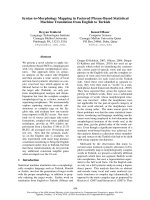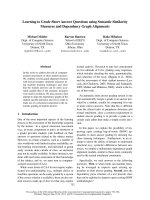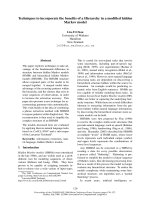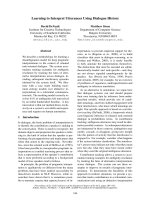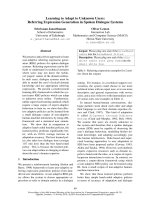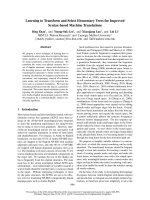Báo cáo khoa học: ""REFERENCE TO LOCATIONS" ppt
Bạn đang xem bản rút gọn của tài liệu. Xem và tải ngay bản đầy đủ của tài liệu tại đây (783 KB, 9 trang )
REFERENCE TO LOCATIONS
Lewis G. Creary, J. Mark Gawron, and John Nerbonne
Hewlett-Packaxd Laboratories, 3U
1501 Page Mill Road
Palo Alto, CA 94304-1126
Abstract
I.I Sketch of Proposal
We propose a semantics for locative expressions
such as near Jones or west of Denver, an impor-
tant subsystem for NLP applications. Locative ex-
pressions denote regions of space, and serve as argu-
ments to predicates, locating objects and events spa-
tially. Since simple locatives occupy argument posi-
tions, they do NOT participate in scope ambiguities m
pace one common view, which sees locatives as logical
operators. Our proposal justifies common representa-
tional practice in computational linguistics, account-
ing for how locative expressions function anaphori-
tally, and explaining a wide range of inference in-
volving locatives. We further demonstrate how the
argument analysis may accommodate multiple loca-
tive arguments in a single predicate. The analysis is
implemented for use in a database query application.
1 Introduction
Locative expressions take diverse forms: in New
York, here, there, nowhere, and on a boat he has
in Ohio. They combine with common nouns (city
on the Rhine), or with verbs or verb-phrases (work
in Boston), always locating objects and situations in
space. Some temporal expressions are similar, but we
focus here on spatial locatives.
The analysis was developed for use in an NLP sys-
tem producing database queries; it is fully imple-
mented and has been in frequent (developmental) use
for 18 months. It is important to provide facilities
for reasoning about location in database query ap-
plications because users typically do not query loca-
tive information in the exact form it appears in the
database. A database may e.g. contain the infor-
mation that a painting is in the Guggenheim Mu-
seum, perhaps even that it's in the Guggenheim in
New York, and yet be helpless when queried whether
that same painting is in the US. In our implementa-
tion information about location is represented using
the logical analysis provided here. I
i of course, the in£ormation that New York is in the US must
be provided by a compatible geographical knowledge base.
The provides general service: first, in collecting the
data relevant to a semantic analysis of locatives; sec-
ond, in presenting the proposal in a fashion which ap-
plies to other natural languages and other logical rep-
resentations; and third, in noting the consequences
of our proposal for the organization of NLP systems,
specifically the cooperation of syntax and semantics.
The behavior of locatives in inference and anaphora
reflects their semantics. This behavior justifies the
hypothesis that (unquantified) locatives refer to re-
gions, while related sequences of locatives refer to
the intersection of the regions associated with their
components. E.g. the phrase (sequence) in
Canada
on the Atlantic Coast refers to the (maximal) region
which is both in Canada and on the Atlantic Coast.
Locative adverbials within a verb phrase will then
be seen to contribute to a location argument in pred-
icates which identifies an area within which the pred-
icate is asserted to hold. The view that locatives
occupy an ARGUMENT position within a predication
is contrasted with the view that they are EXTER-
NAL
OPERATORS (cf. Cresswell [7]), or MODIFIERS on
predications (cf. Davidson [8] or Sondheimer [18]).
In fact, however, the analysis of locative phrases as
arguments jibes well with the practice of most com-
putational linguists; cf. Allen [1], pp.198-207 and the
references there, [1], p.218. The present effort con-
tributes to the justification and explication of this
practice.
Our approach is closest to Jackendoff [12]. We
follow Jackendoff first, in suggesting that locative
phrases are referential in the same way that noun
phrases (NPs) are; and second, in taking locative ad-
verbials to function as arguments. But there is a sig-
nificant foundational problem implicit in the hypoth-
esis that locatives are arguments: locatives, unlike
standard arguments in the predicate calculus, appear
optionally and multiply. Predicate logic does not ac-
commodate the occurrence of multiple arguments in
a single argument position. We solve this techni-
cal problem by allowing that multiple locatives CON-
42
STRAIN a single argument within a predication. This
effectively challenges a standard assumption about
the syntax-semantics interface, viz. how syntactic el-
ements map into arguments, but leads to an elegant
semantics.
In addition to the adverbial use of locatives, we
recognize a predicative use illustrated by (1). We
return to these in Section 6 below.
(I) Tom is in Canada on the Atlantic Coast.
2 The Logic of Locatives
In this section we collect valid and invalid argument-
patterns involving adverbial locatives. A semantics of
locatives should explain the entailments we catalog
here. We restrict our attention initially to locative
phrases in which locations are specified with respect
to logical individuals (denoted by proper names, e.g.
'Boston', 'Jones', or 'Mass Ave') because we assume
that their analysis is relatively uncontroversial. 2 We
begin by noting that any number of locatives may
adjoin to almost any verb (phrase);
(2) Tom works on Mass Ave. in Boston near MIT.
A natural question to ask, then, concerns the logical
relation between complex clauses like (2) and simpler
clauses eliminating one or more of its locatives. To
begin, the SIMPLIFYING INFERENCE in (3) is valid:
(3)
AI works in Boston.
.'. AI works.
Using multiple adjuncts doesn't disturb this pattern
of inference, as (4) and (5) illustrate:
AI works on Mass Ave. in Boston.
(4) ".'. 'AI works in Boston.
(5)
Al works on Mass Ave. in Boston.
.'. Al works on Mass Ave.
PERMUTING
locative adjuncts has no effect on
truth conditions. Thus the sentences in (6) are truth-
conditionally equivalent. Some are less felicitous than
others, and they may manipulate discourse context
differently, but they all describe the same facts:
2We don't think it matters whether the proper names are
taken to be indlvidtud constants, as they normally are, or
whether they are analyzed as restricted parameters, as situ-
ation semantics ([3],pp.165-68) has suggested.
(6)
AI works on Mass Ave in Boston near MIT
AI works near MIT on Mass Ave in Boston
Al works near MIT in Boston on Mass Ave
Al works in Boston near MIT on Mass Ave
AI works in Boston on Mass Ave near MIT
Al works on Mass Ave near MIT in Boston
Even though the simplifying inference in (3) is
valid, we must take care, since the complementary
(accumulative) inference (7) is INVALID (but cf. the
valid (8)):
AI works in NY.
(7) AI works in Boston.
./. AI works in NY in Boston.
AI works in NY.
(8) AI works in Boston.
.'. Al works in NY and in Boston.
Finally, there is what we call the UPWARD MONO-
TONICITY of locatives. If a sentence locating some-
thing at a region R is true, and if R is contained in
the region R ~, then a sentence locating that thing at
R ~ is true:
(9)
A1 works in New York.
New York is in the US.
.'. AI works in the US.
(10)
The dog sleeps under the table.
Under the table is in the house (region
"under the table" is contained in
region "in the house.")
.'. The dog sleeps in the house.
Notice in (10) that the locative phrases are specified
with respect not to locations, but to other logical
individuals. This is accomplished by the semantics
of the prepositions under and in; our proposal will
require that locative PHRASES refer to regions, but
not that their subcomponents must.
3 Other Semantic Evidence
3.1 Scope
Locatives by themselves do NOT induce scope am-
biguity with respect to negation, thus the semantic
nonambiguity of (11); compare that with (12).
(11) Tina didn't work in New York.
(12) Tina didn't drink because of her husband.
43
The causal adjunct becanse of DOES induce a scope
ambiguity with respect to negation. That is why (12)
has two readings, one (narrow scope negation) on
which Tina's not drinking is in some way due to her
husband, another (wide-scope negation) which denies
that Tina's drinking is because of her husband. (11)
shows no analogous scope ambiguity. Thus, locatives
appear to behave differently from at least some other
adjuncts in that they no show no scope variation with
respect to negation.
The simplest explanation of this failure to induce
scope ambiguity is to deny that simple locatives have
scope, i.e. to deny that they are logical operators or
external modifiers. We propose exactly this when we
postulate that they are arguments rather than op-
erators. We grant that locatives in sentence-initial
position DO display properties which suggest scope,
but this needn't vitiate the argument analysis, s
Note that the "commutativity of locatives" shown
in (6) is another indication of failure to scope: loca-
tives fall to scope with respect to each other.
3.1.1 Scope versus Focus
In evaluating the claim that no SCOPE AMBIGUITY is
possible in (11), it is important not to be confused by
the possibility of interpreting the FOCUS of negation
in various ways. The association of negation with
a
focused element is a well-discussed, if not not a
well-understood, phenomenon in the literature (see
Jackendoff ([11], pp.229-78), Chomsky ([4], pp.199-
208), and Rooth [17] for discussions of focus). The
crucial point about focus is that it affects arguments
and adjuncts alike, and that ambiguities involving the
association of negation with focus affect both. For
example,
(13) Elizabeth Browning didn't adore Robert.
The focus can be either on adore or on Robert, giving
different presuppositions, 4 even though the proper
name Robert is never analyzed as scope-inducing.
3.2
Preposed Locatives
PaEPOSED locatives do show properties that resemble
scope. Cf. Thomason and Stalnaker ([21], p.205):
nit is worth emphasizing that we are nanking a semantic
point boa-e there may be a syntactic (attachment) ambiguity
in (11), but it's not one that has any semantic significance.
t Relevant here is Horn's [10] notion of metallnguistic nega-
tion, which accounts for purely contrastive or contradicting
negation. The issues Horn discusses are also orthogonal to
the ambiguity in (12), since the ambiguity persists outside of
contrastive contexts.
In that restaurant, if John is asked to wear a
(14) tie, he wears a tie.
Here the preposed locative does not belong exclu-
sively to either the antecedent or the consequent of
the conditional; rather, the sentence says: if John
is asked to wear a tie in that restaurant, he wears
a tie in that restaurant. Thomason and Stalnaker
argue hence that the locative must be treated seman-
tically as a sentence operator. Cf. Cresswell ([7],
p.217) points out another example where the result
of preposing a locative is not a simple paraphrase of
its "source":
(15) At our house, everyone is eating.
Everyone is eating at our house.
Here there is a reading of the first which can
be paraphrased Everyone at our house is eating,
where the quantifier is restricted to people at our
house. The most important point to make here
is that "preposing" generates new readings, read-
ings unavailable for unpreposed adverbial locatives.
So if these examples are evidence for a sentence-
operator semantics for locatives, then it's a seman-
tics limited to locatives found in this position. The
"wide-scope" readings occur only for locatives in this
"topic" (sentence-initial) position, s It would be se-
mantically implausible to regard the preposed adver-
bials here as mere stylistic variants of nonpreposed
elements, s
• But we note further that locations can be restricted
by discourse context alone:
(16) Joan lived in LA. She often went swimming.
We naturally interpret Joan as swimming in LA; and
such effects can extend indefinitely through discourse.
We propose to analyze both Thomason and Stal-
naker's example and Cresswell's example as R.E-
STRICTINO TOPIC locatives that restrict some loca-
tion roles in the sentence to follow. In the case of
(14), the restriction applies to the locations of both
the antecedent and consequent clauses of the condi-
tional sentence; in the case of (15), the restriction
5Note that this is not normally the case for sentence-
operator adverbials; The number of the planeta is necessarily
nine
is semantically ambiguous between a wide- and narrow-
scope reading of neeessarlb.
eIt
is syntactically implausible as well to regard restrict-
ing topic elements as stylistic variants of unpreposed elements,
since some preposed dements can only occur preposed:
Of the dogs at the show, only Schnauzers were affected.
44
applies to the quantifier Everyone, limiting its do-
main to those individuals at "our house. "7 This has
the consequence that there is a class of restrictive
topic-position modifiers that cannot be analyzed as
preposed adverbials.
3.3 Analogy with NPs
Jackendoff ([12], Chap.3) is partially devoted to ar-
ticulating the strong semantic analogy between loca-
tive phrases and noun phrases. The analogy includes
quantification, a distinction between definite and in-
definite reference, deictic reference, and anaphora.
Jackendoff's programmatic point is that the seman-
tic status of locatives is therefore the same as that of
NPs: they both refer and both function as arguments.
It is noteworthy that locatives have explicitly quan-
tificational forms, as in:
(17) Bill sang everywhere Mary sang.
This suggests that quantified locatives have the same
relationship to simple locatives as general NPs (such
as erery small country) have to singular NPs (such as
the smallest country, a small country, and Honduras).
Though SIMPLE locatives show no scope variation
with respect to other scope operators, quantified loca-
tives (such as everywhere and nowhere) clearly do.
But this scope is due to the quantification, not to the
locative function. Since locatives occupy argument
positions in predications, quantified locatives are sim-
ply quantifications over those predications, exactly
analogous to nonlocative quantifications.
Second, we find similarly noteworthy the indefi-
nitely referring locative somewhere. We note that its
particular reference (like that of someone) is available
for subsequent anaphoric use. That is, (18) may be
understood to claim that Ed works where AI works, s
(18) AI lives somewhere on the Ohio,
and Ed works there.
Third, we note that deictic locative reference is
possible (using here or there), just as deictic non-
locative reference is (using pronouns or demonstra-
tives). We address the fourth and final reminder of
the analogy between NP and locative reference, loca-
tive anaphora, in Section 3.4, immediately below.
~'We don't claim to offer a complete analysis of these
topic-
locatives
(nothing we have said makes it clear how these re-
strictions are enforced, or what the constraints on them are);
but
we offer a plausibility argument that these ewe cases of a
somewhat different color.
SThis contrasts with examples of locative anaphors with
shnple locative antecedents, examined below in Section 3.4.
cf. (19).
3.4 Anaphora
Viewing simple locatives as analogous to singular
NPs, we obtain a simple account of the anaphoric po-
tential of locatives by taking them to denote spatial
regions. The functioning of locatives as antecedents
for the locative pro-form there then provides addi-
tional evidence that simple locatives are in a class
with singular NPs. Consider:
(19) A1 lives on the Ohio, and Ed works there.
(19) makes the claim, not that AI lives in the same
place Ed works, but that he lives on the same river
that AI works on. Thus the reference of both on the
Ohio and there appears to be the entire spatial re-
gion which is ON the Ohio (as opposed to any partic-
ular subregion of it). This region is uniquely (though
vaguely) determined in a given context by the name
of the river and the particular preposition on. We
are, in effect, claiming that the PP on the Ohio acts
as a sort of definite description of a particular spatial
region. Anaphoric reference back to it is reference
back to that same region.
A further note is worthwhile here. If the locative
phrase on the Ohio in (19) refers to the entire region
which may be so described (as we've just argued),
then the LOCATION role of the predicates LIVE and
WORK must be construed as specifying a region 'within
which' a relation is somewhere instantiated. Indeed,
we postulate this as a general property of location
roles within all predicates.
3.5 Regional Intersection
Next consider a more complicated version of (19):
(20) AI lives on the Ohio in Kentucky,
and Ed works there.
In (20) one may understand there as referring to the
intersection of the regions 'on the Ohio,' and 'in Ken-
tucky' (and again, NOT to the particular subpart of
that intersection where AI lives). In fact, this reading
is preferred. (There may also be understood to refer
to one of the component superregious, and our anal-
ysis is fully compatible with this possibility.) Let's
consider how best to supply the intersective reference
for the pronoun there.
In (20) the two locative expressions in the first
clause simultaneously constrain the same location
role. In general, each successive locative in a clause
further narrows the region filling the location role:
(WORK agent
: Ed
(21)
loc : ( n~reg: {0N(Ohio), IN(Kentucky) }))
45
'n~'
is the intersection operation over regions. Cf.
Section 5.2 for formal discussion.
Now, since the filler of a Location role is always
a single region, the anaphoric potential illustrated in
(20) Ls explained. It would remain unexplained if each
locative introduced a distinct predication.
4 Syntax/Semantics Mapping
We employ a syntax/semantics interface that's inno-
vative in two respects: first, we allow that adjuncts
(locatives) be interpreted as arguments, rather than
operators. Cf. McConnell-Ginet ([14],p.167ff) for
a similar proposal about manner adverbs. Second,
we allow that multiple locatives (in the same verb
phrase) jointly determine a single location argument
via the intersection of regions. Thus we allow sev-
eral syntactic dependents corresponding to a single
semantic argument. This challenges a standard work-
ing assumption about the syntax-semantics mapping
made in a number of
frameworks, 9
but it leads to
a neuter semantic account: by allowing several loca-
tive specifiers to constrain a single role, we account
more easily for the permutability of locatives, and we
provide the right range of anaphoric antecedents.
5 Formal Aspects
Here we describe the logical expressions into which
locatives (and sentences containing them) are trans-
lated, and the semantic interpretations of the logical
expressions.
5.1 Overview of NFLT
Our logical formalism is called NFLT. t° It is a modifi-
cation and augmentation of standard predicate calcu-
lus, with two modifications relevant here: predicates
and functors of variable arity, and a semantic inter-
pretation in terms of situation-types.
5.1.1 Predicate and Function Expressions
Predications and functional terms in NFLT have an
explicit rolemark for each argument; in this respect
NFLT resembles semantic network formalisms and
differs from standard predicate calculus, where the
9This doesn't contradict Montague's semantic theoriea, but
it abandons the favored "functional application n mode of inter-
pretation. Cf. Montague [15], p.202. Neither verb (phrase) nor
locative is interpreted as a function applying to the argument
supplied by the other.
l°Cf. Creary and Pollard [6] for conceptual background,
literature references, and more complete presentation of NFLT.
roles are order-coded. For example, atomic formulas
in NFLT are constructed of a base-predicate and a
set of rolemark-argument pairs, as in the following
translation of
Tom works in Boston:
(22) (WORK agent:TOM
location:(IN theme:BOSTON))
The explicit representation of roles permits each
predicate- and function-symbol in NFLT to take a
variable number of arguments, so that different oc-
currences of a verb are represented with the same
predicate-symbol, despite differences in valence (i.e.
number and identity of attached complements and
adjuncts). 11
5.2 Functional Location Terms
Functional location terms are functional terms denot-
ing regions. These are of two general sorts, simple
and intersective. The simple ones consist of a prepo-
sitional functor applied to an appropriate argument,
while the intersective ones consist of a regional in-
tersection functor applied to a set of regions. As an
example, consider the following location term, which
might serve as the translation (in a given context) of
the iterated locatives
on the Ohio in Kentucky near
Illinois:
(23)
(N=reg:{ON3(OHIO),
IN(KENTUCKY),
NEAEI(ILLINOIS)})
This is a complex location term whose components
are simple functional location terms. NE.L~I should
denote (e.g.) a function that maps Illinois onto a
region beginning at its borders and extending out a
short distance.
The functor of an intersective location term de-
notes the regional intersection function, which maps
RI, R~, , Rn onto their intersection R. More for-
mally, we postulate that spatial regions, partially or-
dered by the subregion relation (written __.~), form a
LATTICr The intersection of regions is then their
lattice-theoretic MEET (written 17~), the greatest
lower bound with respect to C,~.
The eommutativity and associativity of n~ jus-
tify specifying its arguments via sets. The order-
indifference of set specification accounts for the per-
mutability of locatives illustrated in (6).
We will also make use of the following familiar lat-
tice theorem:
llIn order to save space, we shall write II(Boston) for (II
the~ : BOSTON),
however.
46
(Ex sub:(rlxreg:{R1,R2, ,
P~})
(24) eup:(l'l=reg:{R1,R2, , P~}) ),
where l~m~
According
to (24), an intersective location
term T
al-
ways denotes a subregion of the region denoted by the
result of deleting some (but not all) of the argument-
terms of T.
5.3 Located Predications
This is a fact about situations being located in space:
if an event or state occurs or obtains within a region
R, then it occurs or obtains within any region R'
containing R:
(25)
(((~ eub:R eup:R')
A (PRED
loc:R))
(PRED
loc:R'))
This is simply a statement of upward monotonicity
for the location arguments of relations. The schemata
(24) and (25) together justify the inference schema
(26)
(g0RK agt;:TOM
loc:(nxreg:{Rl, ,]~}))
.'. (WORK agt:TOM
lo¢:(nxreg:{Rl, ,~})),
where
l~m~n.
This accounts for the correctness of the locative-
simplifying inferences in (4) and (5).
The other sort of simplifying inference given in Sec-
tion 2 was that exemplified in (3), the inference from
Tom's working in Boston to Tom's working. In NFLT
this inference is formulated thus:
(NORK
ag't:TOM loc:IN(BOSTON))
(27)
(woRK ag~:T0X)
Both the premise and the conclusion of (27) are in-
terpreted as denoting situation-types; each is true if
there exists a situation of the type it denotes. Since
every situation of the type denoted by the premise
is necessarily also of the type denoted by the con-
clusion, the truth of the premise necessarily entails
the truth of the conclusion. This accounts for the
validity of (3) in the situation-theoretic framework of
NFLT. In a fixed-arity framework, one would repre-
sent the conclusion as existentially quantifying over a
location argument-position; the inference would then
be existential generalization.
We recall that (7), repeated here for convenience,
is invalid, while the similar (8) (right) is valid:
Tom works in NY.
Tom works in Boston.
.~. Tom works in NY in Boston.
Tom works
in
NY.
Tom works in Boston.
.'. Tom works in NY and in Boston.
The reason is that the premises of the former may
locate two different 'working' events while its conclu-
sion refers to one. The conclusion of the latter, on the
other hand, may refer to distinct 'working' events. Its
translation into NFLT is:
((WORK
agt:TOM loc:IN(~P[)) A
(28) (W0RK ag~:TOM loc:IN(BOSTON)) )
This conclusion is nothing more than the conjunction
of the premises.
6 Adnominal Locatives
We propose above that the ability to induce scope
effects is a litmus test for distinguishing arguments
and operators. This test, together with anaphoric
evidence, suggests a heterodox treatment of adnomi-
nal locatives. In a nutshell, these locatives might be
arguments as well.
(29) Few cars in Ohio rust.
(30) (FEg x (CAR inszance:x loc:IN(0HI0))
(RUST thm:x))
There is a reasonable competing (predicative) analy-
sis of the use of adnominal locatives, however.
(31)
(FEW x
((CAR instance:x) A
(LOCATED thm:x loc:IN(0HI0)))
(RUST ~ha:x))
Note that in both formulations there is reference to
a region, and that the locative cannot participate in
scope ambiguities. 12
12We
leave as an exercise for the reader to show that the
well known (semantically significant) attachment ambiguity
between adverbial and adnominal loactives may be represented
h~re:
Tom
evaluated a car in Ohio.
47
7 Other Proposals
7.1 External Operator Analysis
Cresswell ([7], p.13) poses the problem of analysis for
adverbial modification thus:
There are two basic approaches to the
analysis of adverbial constructions [ ] One
is to follow Richard Montague and treat
them as sentential operators of the same
syntactical category as
not.
The other is to
follow Donald Davidson and represent them
in the predicate calculus with the aid of an
extra argument place in the verb to be mod-
ified [ ]
We suspect that Cresswell would classify the tack
taken toward locative adverbials in this paper as an
"extra argument" analysis, but we shall note be-
low some important differences between our approach
and Davidson's.
We find fault with the operator analysis of locative
adverbials since it inherently attributes a scope to
locatives which, as Section 3.1 shows, isn't reflected
in natural language semantics. It is also clear that
the simplifying and commutative inferences for loca-
tives noted in Section 2 are not predicted by the ex-
ternal operator analysis. Locatives wouldn't neces-
sarily have these properties any more than negation
or the modal adverbs. Finally, we note as problem-
atic the comportment of the operator analysis with
the anaphoric evidence, particularly where multiple
locatives are concerned.
7.2 Davidsonian Analyses
Davidson [8], and, following him, Bartsch [2] and
Sondheimer [18] have proposed that adverbial modifi-
cation is best represented using an unexpected argu-
ment place within a predicate. Bartsch ([2], pp.122-
39) and Sondheimer [18] focus on locative construc-
tions, so we concentrate on those works here. Sond-
heimer ([18], pp.237-39) provides the following anal-
ysis:
(32)
John stumbled in the park under a tree.
3e(Stmbl(J,e) A In(e,p) A Under(e,t))
The standard logic textbook representation of an in-
transitive verb such as
stumble
uses a ONE-PLACE
predicate, where Sondheimer, following Davidson,
uses the TWO-PLACE predicate signifying a relation
between an individual and an event. This is the "ex-
tra argument place" that distinguishes Davidsonian
treatments. It is worth noting that this approach ac-
counts for the logical properties of locatives that we
noted in Section (2) above. The simplification and
commutativity of locatives follow from the proposi-
tional
logic of conjunction.
The most important differences between Davidso-
nian analyses and our own are the ability to account
for locative anaphors, and the treatment of scope.
As presented in Section 3.4 above, our treatment
provides correct regional antecedents for the loca-
tive anaphor
there.
On the other hand, Davidsonian
treatments make no explicit reference to regions at all
(to which anaphors might refer), and further provide
no mechanism for referring to the intersective regions
that were seen to be required in the analysis of (20).
Our analysis places simple locatives within the
scope of all sentence operators. The Davidsonian
analysis creates multiple propositions, and scope-
inducing elements such as negation can then be ana-
lyzed as including some, but not all of these proposi-
tions within their scope. For this reason, Davidsonian
treatments are much less specific in their predictions
vis-a-vis scope (than the one proposed here). Bartsch
([2], p.133) indicates e.g. that she would allow sen-
tential negation to have scope over some of the con-
juncts in logical forms such as (32), but not others;
and Sondheirner ([18], p.250) seems to have a similar
move in mind in his discussion of almost as in I al-
most locked him in the closet. As indicated in Section
3.2 above, we regard such renderings as confusions of
scope and focus.
7.3 Other Works
Jackendoff ([12], Chap.3,9) argues that reference to
places be recognized in semantic theory, thus allow-
ing that locative phrases refer in the same way that
NPs do, and that they function as arguments. But
Jackendoff never examined inferences involving loca-
tives, nor did he attempt to deal with the prima fa-
cie difficulties of the argument analysis the fact that
locatives occur optionally and multiply. It is the lat-
ter facts which make the argument analysis techni-
cally difficult. Finally, where we have been precise
about the semantics of the location role, emphasizing
that it specifies a region WITHIN WHICH a relation
must hold, Jackendoff was less exact. On the other
hand, Jackendoff's analysis of PATH EXPRESSIONS is
intriguingly analogous to that of locatives, and offers
opportunity for extension of the work here.
Colban ([5]) analyzes locatives in situation seman-
tics, and would like to have the operator/argument
48
issue both ways: he allows that locatives might be
external modifiers or arguments. But he offers no ev-
idence to support this postulate of ambiguity. Ter
Meulen ([20], also working within situation seman-
tics, provides a means of referring to the location of
complex events, such as the event of two detectives (33)
solving a crime. She crucially requires a reference for
locative expressions, and her proposals seem compat-
ible with ours.
Talmy [19], Herskovits [9], and Kautz [13] theorize
about the INTERPRETATION of locative expressions,
and especially how this is affected by the sorts of ob-
jects referred to in locative expressions. Much of this
latter work may be regarded as complementary to our
own, since we have not attempted to characterize in
any detail the manner in which context affects the (34)
choice of functional denotation for particular locative
prepositions.
8 Conclusions
8.1 Claims
1.
.
.
4.
Locative expressions (e.g. north of Boston near
Harry) denote regions of space. The denotations
may be referred to anaphorically.
Locative expressions are used adverbially to con-
strain a location argument in a relation defined
by a verb. Thus simple locatives fail to show
scope (like proper names).
Relations are upwardly monotonic at location ar-
guments: if a relation holds at R, then it holds
at every containing R I.
When multiple locatives are used, the intersec-
tion of their denoted regions plays 8 location
role. This describes the truth conditions and
anaphoric potential of such uses, and predicts
correctly the permutability and omissibility of
locatives.
8.2 Qualifications
We don't claim that all reference to regions is through
upwardly monotonic location arguments. On the
contrary, regions can stand in relations in a variety
of other ways. To take an obvious case, the sub-
region relation is upwardly monotonic (transitive),
but only in one (superregion) argument it's not up-
wardly monotonic in the first (subregion) argument.
Here are two more fairly transparent examples of ref-
erence to locations that don't involve the location at-
guments of predicates, and therefore aren't upwardly
monotonic:
Tom likes it in Mendocino.
./. Tom likes it in California.
George VI ruled in England.
./. George VI ruled in Europe.
We claim that the regions referred to in (33) aren't
location arguments, but rather theme (or patient) ar-
guments. There are other examples of monotonicity
failing that are less easily dismissed, however:
It is the tallest in Palo Alto
./. It is the tallest in California.
He is alone in the dining room.
.f. He is alone in the house.
The apparent location argument of these relations
(and of all superlatives) is especially interesting be-
cause it not only fails to be
upwardly
monotonic, it
even turns out to be
downwardly
monotonic. We wish
to deny that these phrases denote regions which play
location roles more specifically, we allow that the
phrases denote regions, but we distinguish the seman-
tic role that the regions play. In the case of LOCATION
arguments, the intended semantics requires that the
relation hold
somewhere
within the region denoted.
In the case of (34), however, the relation can only
hold be said to hold if it holds
fhrougho,t
the region
denoted. It is this implicit (universal) quantification
that explains the failure of upward monotonicity, of
course. We symbolize this sort of role as "throughout,
and represent the downwardly monotonic (34) in the
following way:
(TALLEST tim: •
(35) throughout : In (Pa.Zo-Alt o) )
(We emphasize that this is intended to illustrate
the distinction between the various semantic
roles
that locations play it is not proferred as a serious
analysis of the superlative.)
8.3 Future Directions
We'd like to improve this account in several ways:
first, we'd like to understand the interface between
the syntax and semantics more rigorously. Section 4
explains what is unusual about our views here, but
the model of syntax/semantics cooperation it sug-
gests is something we'd like to explore. Second, we
need an account of preposed locatives, as Section 3.2
49
admits. Third, we'd like to describe the relationship
between predicates relating objects and regions on
the one hand with regions occupied by the objects, as
Section 6 shows. Fourth, we'd be interested in explor-
ing the relation between our work on the semantics
of locatives with work on the contextually dependent
interpretation of locatives, such as the work by Her-
skovits [9] and Retz-Schmidt [16].
9 Acknowledgements
We're indebted to Carl Pollard for the suggestion to
use the algebraic operator 'N~ We'd like to thank
him, Barbara Partee, David Dowry, and our col-
leagues in the Natural Language Project at Hewlett-
Packard Laboratories, especially Bill Ladusaw, for
discussion and criticism of the ideas presented here.
References
[1] James Allen. Natural Language Understanding.
Benjamin/Cummings, Menlo Park, 1987.
[2] l~nate Bartsch. Adverbialsemantik. Athenaum,
Frankfurt, 1972.
[3] Jon Barwise and John Perry. Situations and At-
titudes. MIT Press, Cambridge, 1983.
[41
Noam A. Chomsky. Deep structure, surface
structure, and semantic interpretation. In
Danny D. Steinberg and Leon A. Jacobovits, ed-
itors,
Semantics: An Interdiscipinary Reader in
Philosophy, Linguistics, and Psychology, pages
183-216. Cambridge University Press, Cam-
bridge, 1970.
[5]
Erik Colban. Prepositional phrases in situation
schemata. In Jens Erik Fenstad, Per-Kristian
Halvorsen, Tore Langholm, and Johan van Ben-
them, editors, Situations, Language, and Logic,
pages 133-156. Reidel, Dordrecht, 1987.
[6]
Lewis G. Creary and Carl J. Pollard. A compu-
tational semantics for natural language. In Pro-
ceedings
of the ~Sth Annual Meeting of the As-
sociation for Computational Linguistics, pages
172-179, 1985.
IT]
M. J. CressweU. Adverbial Modification: Interval
Semantics and its Rivals. D.Reidel, Dordrecht,
1985.
[8] Donald Davidson. The logical form of action sen-
tences. In Nicholas Rescher, editor, The Logic of
Decision and Action, pages 81-95. University of
Pittsburgh Press, Pittsburgh, 1967.
[9] Annette Herskovits. Space and Prepositions
in English: Regularities and Irregularities in a
Complez Domain. Cambridge University Press,
Cambridge, England, 1985.
[10] Laurence R. Horn. Metafinguistic negation and
pragmatic ambiguity. Language, 61(1):121-174,
1985.
[11] Ray Jackendoff. Semantics Interpretation in
Generative Grammar. MIT Press, Cambridge,
1972.
[12] Ray Jackendoff. Semantics and Cognition. MIT
Press, Cambridge, Massachusetts, 1983.
[13] Henry A. Kautz. Formalizing spatial concepts
and spatial concepts. In Hobbs et at., editor,
Commonsense Summer: Final Report, pages
2.1-2.45. CSLI, 1985.
[14] Sally McConnell-Ginet. Adverbs and logical
form. Language, 58(1):144-184, 1982.
[15] Richard Montague. English as a formal lan-
guage. In Bruno Visentini, editor, Lingnaggi
neUa societa e nella tecnica. Edizioni di Comu-
nita, Milan, 1970.
[16] Gudula Retz-Schmidt. Various views on spatial
prepositions. AI Magazine, 9(2):95-105, 1988.
[17] Mats Rooth. Association and Focus. PhD thesis,
University of Massachusetts at Amherst, 1986.
[18] Norman K. Sondheimer. Reference to spatial
properties. Linguistics and Philosophy, 2(2),
1978.
[19] Leonard Talmy. How language structures space.
In Herbert Pick and Linda Acredolo, editors,
Spatial Orientation: Theory, Research, and Ap-
plication. Plenum Press, 1983.
[20] Alice ter Meulen. Locating events. In
Jeroen Groenendijk, Dick de Jongh, and Mar-
tin Stokhof, editors, Foundations of Pragmatics
and Lezical Semantics, pages 27-40. Forts, Dor-
drecht, 1986.
[21] Richmond Thomason and Robert Stalnaker. A
semantic theory of adverbs. Linguistic Inquiry,
4(2), 1973.
5O



